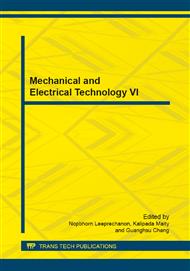[1]
Fraser, J. M., & Posey, J. W. (1989). A framework for replacement decisions. European Journal of Operational Research, 40, 43–57.
Google Scholar
[2]
Hopp, W. J., & Nair, S. K. (1991). Timing replacement decisions under discontinuous technological change. Naval Research Logistics, 38, 203–220.
DOI: 10.1002/1520-6750(199104)38:2<203::aid-nav3220380207>3.0.co;2-e
Google Scholar
[3]
Bean, J. C., Lohmann, J. R., & Smith, R. L. (1994). Equipment replacement under technological change. Naval Research Logistics, 41, 117–128.
DOI: 10.1002/1520-6750(199402)41:1<117::aid-nav3220410108>3.0.co;2-u
Google Scholar
[4]
Hartman, J. C. (1999). A general procedure for incorporating asset utilization decisions into replacement analysis. The Engineering Economist, 44, 217–238.
DOI: 10.1080/00137919908967521
Google Scholar
[5]
Karabakal, N., Lohmann, J. R., & Bean, J. C. (1994). Parallel replacement under capital rationing constraints. Management Science, 40, 305–319.
DOI: 10.1287/mnsc.40.3.305
Google Scholar
[6]
Jones, P. C., Zydiak, J. L., & Hopp, W. J. (1991). Parallel machine replacement. Naval Research Logistics, 38, 351–365.
DOI: 10.1002/1520-6750(199106)38:3<351::aid-nav3220380306>3.0.co;2-u
Google Scholar
[7]
Hopp, W. J., Jones, P. C., & Zydiak, J. L. (1993). A further note on parallel machine replacement. Naval Research Logistics, 40, 575–579.
DOI: 10.1002/1520-6750(199306)40:4<575::aid-nav3220400411>3.0.co;2-d
Google Scholar
[8]
Tang, J., & Tang, K. (1993). A note on parallel machine replacement. Naval Research Logistics, 40, 551–555.
DOI: 10.1002/1520-6750(199306)40:4<569::aid-nav3220400410>3.0.co;2-f
Google Scholar
[9]
Chen, Z. (1998). Solution algorithms for the parallel replacement problem under economy of scale. Naval Research Logistics, 45, 279–295.
DOI: 10.1002/(sici)1520-6750(199804)45:3<279::aid-nav3>3.0.co;2-4
Google Scholar
[10]
Hartman, J. C. (2000). The parallel replacement problem with demand and capital budgeting constraints. Naval Research Logistics, 47, 40–56.
DOI: 10.1002/(sici)1520-6750(200002)47:1<40::aid-nav3>3.0.co;2-t
Google Scholar
[11]
Hartman, J. C. (2001). An economic replacement model with probabilistic asset utilization. IIE Transactions, 33, 717–727.
DOI: 10.1080/07408170108936868
Google Scholar
[12]
Hartman, J. C. (2004). Multiple asset replacement analysis under variable utilization and stochastic demand. European Journal of Operational Research, 159, 145–165.
DOI: 10.1016/s0377-2217(03)00397-7
Google Scholar
[13]
Hartman, J. C. (2006). Finite-horizon equipment replacement analysis. IIE Transactions, 38, 409–419.
DOI: 10.1080/07408170500380054
Google Scholar
[14]
Hartman, J. C., & Ban, J. (2002). The series-parallel replacement problem. Robotics and Computer Integrated Manufacturing, 18, 215–221.
DOI: 10.1016/s0736-5845(02)00012-1
Google Scholar
[15]
Chang, P. T. (2005). Fuzzy strategic replacement analysis. European Journal of Operational Research, 160, 532–559.
DOI: 10.1016/j.ejor.2003.07.001
Google Scholar
[16]
Hritonenko, N., Yatsenko Y. (2009). Integral equation of optimal replacement analysis and algorithms. Applied Mathematical Modelling, 33, 2737-2747.
DOI: 10.1016/j.apm.2008.08.007
Google Scholar
[17]
Redmer, A. (2009). Optimisation of the exploitation period of individual vehicles in freight transportation companies. Transportation Research Part E 45 978–987.
DOI: 10.1016/j.tre.2009.04.015
Google Scholar
[18]
Parthanadee, P., Buddhakulsomsiri, J., Charnsethikul, P. (2012).
Google Scholar


